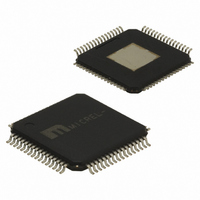SY89828LHG Micrel Inc, SY89828LHG Datasheet - Page 8

SY89828LHG
Manufacturer Part Number
SY89828LHG
Description
IC BUFFER DUAL 1:10 IVDS 64-TQFP
Manufacturer
Micrel Inc
Series
Precision Edge®r
Type
Fanout Buffer (Distribution), Multiplexer , Translatorr
Specifications of SY89828LHG
Number Of Circuits
2
Ratio - Input:output
2:10
Differential - Input:output
Yes/Yes
Input
LVDS, PECL
Output
LVDS
Frequency - Max
1GHz
Voltage - Supply
3 V ~ 3.6 V
Operating Temperature
-40°C ~ 85°C
Mounting Type
Surface Mount
Package / Case
64-TQFP Exposed Pad, 64-eTQFP, 64-HTQFP, 64-VQFP
Frequency-max
1GHz
Clock Ic Type
Clock Buffer
Frequency
1GHz
No. Of Outputs
10
Supply Current
45mA
Supply Voltage Range
3V To 3.6V
Digital Ic Case Style
TQFP
No. Of Pins
64
Operating Temperature Range
-40°C To
Lead Free Status / RoHS Status
Lead free / RoHS Compliant
Available stocks
Company
Part Number
Manufacturer
Quantity
Price
Micrel, Inc.
V
Symbol
f
t
t
t
t
t
t
t
t
Note 1.
Note 2.
Note 3.
Note 4.
Note 5.
Note 6.
Note 7.
Note 8.
M9999-012208
hbwhelp@micrel.com or (408) 955-1690
MAX
PHL
PLH
SWITCHOVER
S(OE)
H(OE)
SKEW
JITTER
r
, t
CC
AC ELECTRICAL CHARACTERISTICS
f
= 3.3V ±10%, T
100Ω termination between Q and /Q outputs. Airflow ≥300lfpm, or exposed pad soldered to ground plane.
f
Differential propagation delay is defined as the delay from the crossing point of the differential input signals to the crossing point of the differential
output signals.
Set-up and hold time applies to synchronous applications that intend to enable/disable before the next clock cycle. For asynchronous applications,
set-up and hold time does not apply. OE set-up time is defined with respect to the rising edge of the clock. OE HIGH to LOW transition ensures
outputs remain disabled during the next clock cycle. OE LOW to HIGH transition enables normal operation of the next input clock.
The within-device skew is defined as the worst case difference between any two similar delay paths within a single device identical input transition,
operating at the same voltage and temperature.
The part-to-part skew is defined as the absolute worst case difference between any two delay paths on any two devices operating at the same voltage
and temperature. Part-to-part skew is the total skew difference; pin-to-pin skew + part-to-part skew.
Cycle-to-cycle jitter definition: The variation period between adjacent cycles over a random sample of adjacent cycle pairs. T
where T is the time between rising edges of the output signal.
Total jitter definition: with an ideal clock input, no more than one output edge in 10
to-peak jitter value.
MAX
is defined as the maximum toggle frequency, measured with a 750mV LVPECL input or 350mV LVDS input. Outut swing is > 200mV.
Parameter
Maximum Toggle Frequency
Differential Propagation Delay
Note 3
Clock Input Switchover
Output Enable Set-Up Time
Output Enable Hold Time
Within Device Skew
Part-to-Part Skew
Cycle-to-Cycle
Total Jitter
Output Rise/Fall Times
(20% to 80%)
A
= –40°C to +85°C, unless noted.
Condition
Note 2
LVPECL Input: 150mV
LVPECL Input: 800mV
LVDS Input: 100mV
LVDS Input: 400mV
CLK_SEL to Valid Output
Note 4
Note 4
Note 5
Note 6
Note 7
Note 8
(NOTE 1)
8
12
output edges will deviate by more than the specified peak-
0°C to +85°C
–40°C
0.950
0.950
0.80
1.10
Min
200
1.0
1.0
0.5
1.15
1.35
1.20
1.55
Typ
290
1.0
25
35
<1
JITTER_CC
Precision Edge
1.450
Max
1.45
1.60
1.85
400
400
1.3
50
75
<1
2
SY89828L
= Tn –Tn+1
ps
Units
GHz
ps
ns
ns
ns
ns
ns
ns
ns
ps
ps
ps
ps
RMS
PP
®















